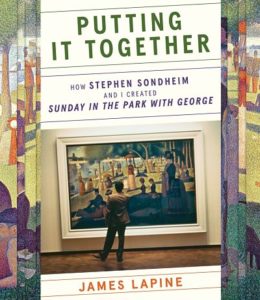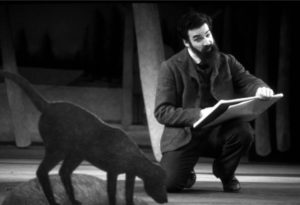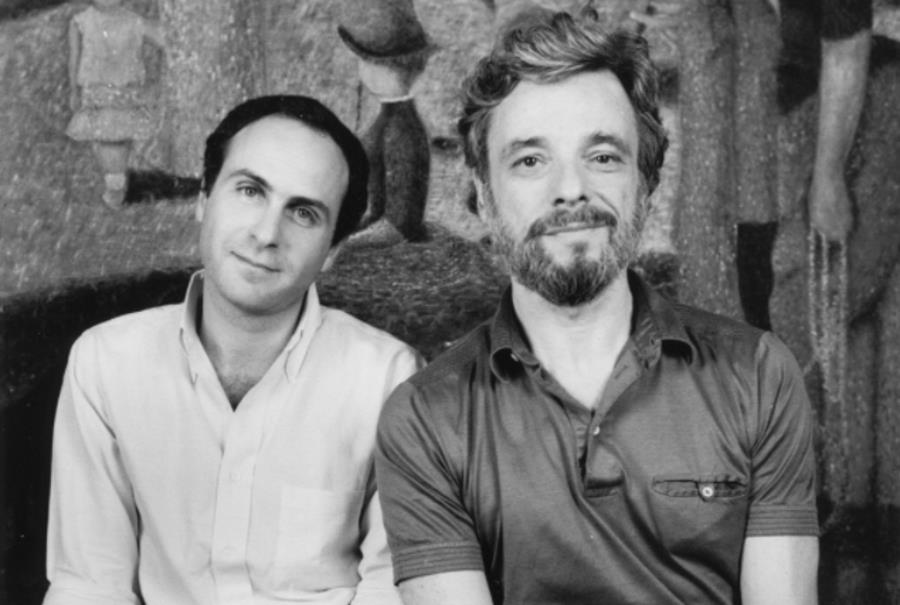The first time James Lapine met Stephen Sondheim, on June 12, 1982, the composer lit a joint in the living room of his Manhattan townhouse and passed it to his young visitor. “I just figured that anybody of your generation smoked dope all the time, which was true,” Sondheim recalls in Putting It Together, Lapine’s delicious new memoir/oral history of the making of Sunday in the Park With George. Thus began the unlikely partnership between a fledgling playwright/director and a Broadway luminary 20 years his senior. Four decades later, Lapine looks back at their first collaboration with affection and generosity, aided by the recollections of Sondheim and three dozen others involved with the production.
For those old enough to remember the bumpy gestation of Sunday, a musical based on a painting by 19th-century French artist Georges Seurat, Putting It Together addresses every unanswered question about the show in riveting detail. For younger generations of theatremakers and fans, the book may seem like a dispatch from an alternate universe, one in which a musical could begin previews on Broadway with a second act so unfinished that audiences got a two-sheet Xeroxed “program” rather than a Playbill. (Fun fact: I still have mine, with a song list that doesn’t include “Children and Art” or “Lesson #8,” which were added the night before critics arrived.)
In his introduction to the book, Lapine explains that he felt compelled to explore the origins of Sunday in the Park With George, which went on to receive 10 Tony nominations and the 1985 Pulitzer Prize for Drama, while watching Jake Gyllenhaal play the title role in the 2017 Broadway revival. “After about 20 minutes or so,” he writes, “a voice came in my head: Who wrote this peculiar musical?” Having lived through the “complicated and occasionally painful” experience of writing and directing the show on and off Broadway, he decided to compare notes with surviving members of the original cast and creative team—and his interviewees didn’t hold back.

Under Lapine’s friendly but persistent questioning, the Sunday alums share memories that don’t always reflect well on him, from lead producer Emanuel Azenberg’s confession that he didn’t understand or even enjoy the show (!) to an examination of Lapine’s then-contentious relationship with Mandy Patinkin. (When the volatile star threatened to quit early on, Patinkin’s wife, Kathryn Grody, advised the director, “Just tell him you love him.”) At one point, Brent Spiner chafed when Lapine told him, “You’re not a character, you’re a color,” and Bernadette Peters, among others, seemed puzzled at being asked to play improv games during rehearsal. “When I finally just accepted the fact that everyone didn’t like me and moved on, the better I got at my job,” Lapine writes with typical equanimity.
Fortunately, the one person who really mattered—Sondheim—did like Lapine, and embraced his open-ended work process. The two met six months after Merrily We Roll Along, Sondheim’s final collaboration with director Hal Prince, crashed and burned on Broadway. “I thought, I don’t want to be in this profession; it’s just too hostile and mean-spirited,” he tells Lapine in Putting It Together. “I thought, I’d love to invent games, video games…but then I saw Twelve Dreams.” A shrewd judge of talent, Sondheim admired the originality of Lapine’s 1981 play, based on psychiatrist Carl Jung’s case studies; for his part, Lapine understood Sondheim’s legendary status but had seen only one of his shows, Sweeney Todd, and was unfamiliar with his previous hits. Nevertheless, they felt an immediate bond that eventually resulted not only in Sunday in the Park With George but also the crowd-pleasing Into the Woods (1987) and the cult favorite Passion (1994).

Though Lapine doesn’t press the point, it’s clear that he—a former graphic designer—drove the creation of their “peculiar” first musical. After presenting Sondheim with a postcard of Seurat’s A Sunday Afternoon on the Island of La Grande Jatte, he fleshed out the characters in the painting and arranged a reading of his first draft before the composer wrote a single note. Indeed, both were secretly thinking the partnership might not work out: Lapine worried that Sondheim would never finish a song; Sondheim repeatedly suggested that the material would make a good play. The push-pull of their relationship, and the way they ultimately brought out the best in each other, is one of the loveliest elements in the book.
There’s much more to Putting It Together than a juicy oral history (though who can resist stage manager Loretta Robertson confessing that crew members called the show “Sunday in the Dark and Bored”?). The book includes script pages, Sondheim’s handwritten notes and lyric ideas, previously unseen personal photos, and the complete text of the finished show. Most important, Lapine’s own recollections, presented chronologically, create a narrative drive rare in books of this kind. Also rare: The opportunity to hear a still-active theatre artist, whose latest musical, Flying Over Sunset, begins performances in November at Lincoln Center Theater, reflect in unsparing detail on the seminal work of his youth. Sixteen months after America’s stages suddenly went dark, Putting It Together is a blast of theatrical oxygen, reminding us, as Sunday in the Park did, that creating art is messy and difficult and not to be taken for granted.
Kathy Henderson (she/her) is a writer and editor based in New York City.


